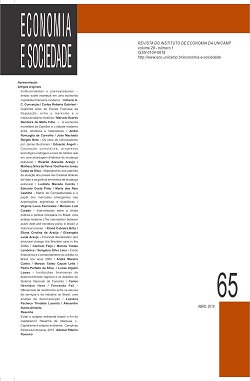Abstract
The present study aims to develop a multi-sectoral cumulative causation model with endogenous technological progress and the real exchange rate. The literature on export-led growth, originally based on the model constructed by Dixon and Thirlwall (1979), advanced to a multi-sectoral approach developed by Araujo (2013). However, the multisectoral model originally developed by Araujo and Lima (2007) disregards the exchange rate and maintains the rate of change in labor productivity at null. Thus, we intend to advance the theoretical debate by introducing endogenous technological progress and the real exchange rate in the Law of Multi-Sectoral Thirlwall to the Pasinettian model. The study makes an important contribution in terms of enabling policy makers to identify which sectors contribute most to the long-term growth of the domestic economy as well as providing economic and industrial policies to improve trade relations and the competitiveness of the economy, to drive the economy to a higher stage of development.
References
ARAUJO, R. A. Cumulative causation in a structural economic dynamic approach to economic growth and uneven development. MPRA (Munich Personal RePEc Archive), v. 24, p. 1-24, Mar. 2011.
ARAUJO, R. A. New insights from a structural economic dynamic approach to balance of payments constrained growth. MPRA (Munich Personal RePEc Archive), 2011 b.
ARAUJO, R. A.; LIMA, G. T. A structural economics-dynamics approach to balance- of payments constrained growth. Cambridge Journal of Economics, p. 755-774, 2007.
ARAUJO, R.; TEIXEIRA, J. A multi-sector version of the post-Keynesian growth model. In: INTERNATIONAL COLLOQUIUM ON GROWTH, STRUCTURAL CHANGE AND INSTITUTIONS, 8. Proceedings… Ed. by T. Boyland and S. Raghavendra. Galway, Ireland, 2011. p. 25-46.
BOTTA, A. A structuralist north-south model on structural change, economic growth and catching-up. Structural Change and Economic Dynamics, v. 20, p. 61-73, 2009.
BRUTON, H. A reconsideration of import substitution. Journal of Economic Literature, v. 36, p. 903-936, 1998.
CORNWALL, J.; CORNWALL,W. A demand and supply analysis of productivity growth. Structural Change and Economic Dynamics, v. 13, n. 2, p. 203-229, 2002.
D’AGATA, A. Endogenous adaptative dynamics in Pasinetti model of structural change. Metroeconomica, v. 61, n. 2, p. 333-363, 2010.
FIORILLO, F. Rate of growth and sector specialisation coevolution in a Kaldorian export-led growth model. Structural Change and Economic Dynamics, Elsevier, v. 12, n. 1, p. 91-114, Mar. 2001.
KALDOR, N. A model of economic growth. The Economic Journal, v. 67, n. 268, p. 591-624, Dec. 1957.
KALDOR, N. Causes of the slow rate of growth of the United Kingdom. Cambridge: [s.n.]. 1966.
KALDOR, N. Strategic factors in economic development. Ithaca, NY: New York State School of Industrial and Laubour Relations. Cornell University, 1967.
KALDOR, N. The role of effective demand in the short run and the long run. In: BARRÉRE, A. The foundations of Keynesian analysis. London: MacMillan Press, 1988.
KRUGMAN, P. R. Trigger strategies and price dynamics in equity and foreign exchange markets. National Bureau of Economic Research, Inc.,1987. (NBER Working Papers, n. 2459).
McCOMBIE, J. S. L.; THIRLWALL, A. P. Economic growth and the balance-of-payments constraint. London: The Macmillan Press, 1994.
MORENO-BRID, J. C. Balance-of-paymens constraines economic growth: the case of Mexico. Banca Nazionale del Lavoro Quarterly Review, p. 413-433, 1998.
OCAMPO, A. Beyond reforms: structural dynamics and macroeconomic vulnerability. Stanford University Press, 2005.
PASINETTI, L. L. Structural economic dynamics. Cambridge: Cambrigde University Press, 1993.
PASINETTI, L. L. Structural change and economic growth: a theoretical essay on the dynamics of the wealth of nations. Cambridge University Press, 1983.
REATI, A. Technological revolutions in Pasinetti’s model of structural change: productivity and prices. Structural Change and Economic Dynamics, v. 9, n. 2, p. 245-262, Jun. 1998.
ROBERTS M.; SETTERFIELD M. What is endogenous growth theory? In: ARESTIS, P.; BADDELEY, M.; McCOMBIE, J. S. L. (Ed.). Economic growth: new directions in theory and policy. Cheltenham: Edward Elgar, 2007.
SETTERFIELD, M. History versus equilibrium and the theory of economic growth. Cambridge Journal of Economics, Oxford University Press, v. 21, n. 3, p. 365-378, May 1997.
THIRLWALL, A. P. The balance of payments constraint as an explanation of international growth rates differences. Banca Nazionale del Lavoro Quarterly, p. 44-55, 1979.
THIRLWALL, A. P.; HUSSAIN, M. N. The balance of payments constraint, capital flows and growth rate differences between developing countries. Oxford Economic Papers: New Series, 1982.
THIRLWALL. A. P. A plain man’s guide to Kaldor’s growth laws. Journal of Post Keynesian Economics, v. 5, n. 3, p. 345-358, Spring 1983.
VERHULST, P. F. Notice sur la loi que la population pursuit dans son accroissement. corresp. Math. Phys, v. 10, p.113-121, 1838.
A Economia e Sociedade utiliza a licença do Creative Commons (CC), preservando assim, a integridade dos artigos em ambiente de acesso aberto.


